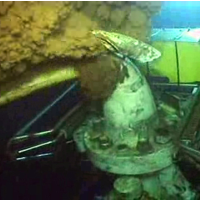Federal Report on Gulf of Mexico Oil Drilling Explosion Warns of Future Disasters
 Oil leaking from Deepwater Horizon blowout preventer
Oil leaking from Deepwater Horizon blowout preventer
A report that identified the cause of the 2010 BP Gulf of Mexico oil spill says a similar disaster could happen again despite improvements in regulations since the accident.
The spill happened because the rig’s blowout preventer failed to seal the well because of a buckled drilling pipe, according to a draft report from the U.S. Chemical Safety Board (CSB). The report identified several problems with the preventer and with procedures by BP and Transocean, which owned the Deepwater Horizon drilling rig.
“[W]hile Deepwater Horizon personnel performed regular tests and inspections of those BOP [blowout preventer] components that were necessary for day-to-day drilling operations, neither Transocean nor BP had performed regular inspections or testing to identify latent failures of the BOP’s emergency systems,” the report said. “As a result, the safety-critical BOP systems responsible for shearing drill pipe in emergency situations – and safely sealing an out-of-control well – were compromised before the BOP was even deployed to the Macondo wellhead.”
The blowout caused an explosion on the drilling rig that killed 11 people. The subsequent spill went on for 87 days and was the largest such disaster in history.
Cheryl MacKenzie, who led the investigation, said another such blowout is not out of the question. “Although there have been regulatory improvements since the accident, the effective management of safety critical elements has yet to be established,” MacKenzie said. “This results in potential safety gaps in U.S. offshore operations and leaves open the possibility of another similar catastrophic accident.”
Despite the problems, the board concluded that the BOP would have worked had the drill pipe not buckled. However, investigators weren’t able to find the cause of the buckling, although they did determine that it probably happened within the first few minutes of the blowout.
BP spokesman Geoff Morrell told The New York Times that some CSB conclusions, including the theory that the blowout preventer “could not cut the drill pipe because the pipe had buckled before the explosion on the rig due to pressure differentials.” were “based on flawed assumptions.”
CSB chairman Rafael Moure-Eraso said in a statement that drilling safety standards should be tougher. “Drilling continues to extend to new depths, and operations in increasingly challenging environments, such as the Arctic, are being planned,” he said. “To maintain a leadership position, the U.S. should adopt rigorous management methods that go beyond current industry best practices.”
-Steve Straehley
To Learn More:
Fixes After BP Spill Not Enough, Board Says (by Clifford Krauss, New York Times)
EPA Lets BP Back into the Gulf of Mexico 4 Years after Deepwater Horizon Disaster (by Noel Brinkerhoff, AllGov)
BP, at Trial, Tries to Prove it was Merely “Negligent,” not “Grossly Negligent” (by Noel Brinkerhoff, AllGov)
- Top Stories
- Unusual News
- Where is the Money Going?
- Controversies
- U.S. and the World
- Appointments and Resignations
- Latest News
- Trump to Stop Deportations If…
- Trump Denounces World Series
- What If China Invaded the United States?
- Donald Trump Has a Mental Health Problem and It Has a Name
- Trump Goes on Renaming Frenzy






Comments